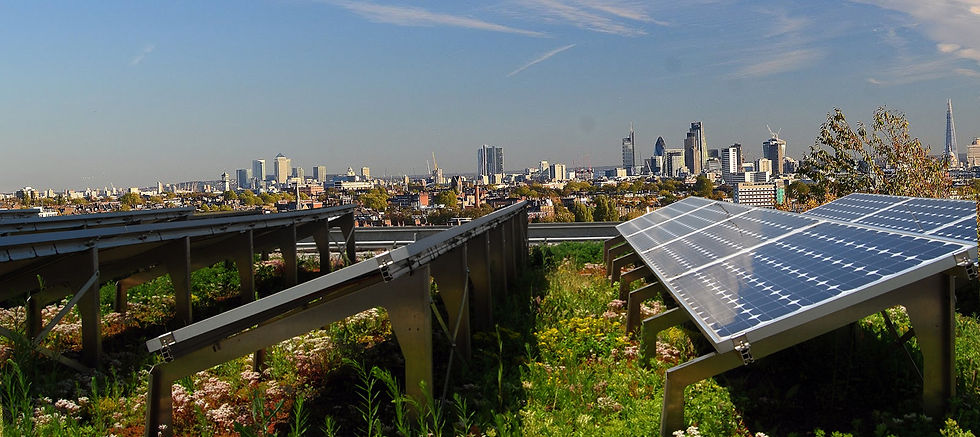E Pluribus Green - Green's A Community Thing
- Melissa Baldridge
- Apr 30, 2016
- 4 min read

Making the case for big-ticket green features in home and building boils down to one question – Who’s gonna own it?
And often the answer makes a whole lot more sense when it’s a “we” rather than a “me.”
I’m not talking about changing light bulbs and easy, affordable measures with paybacks of a couple of years. I mean the really big stuff – like larger solar arrays and solar hot water, geothermal heat pumps, and small wind projects. In other words, there’s greater purchasing power when a group of owners band together as a single entity rather than each owner separately springing for these features.
In real estate law here, the Colorado Common Interest Ownership Act (CCIOA) governs groups of property owners who can pool resources to purchase and maintain features – in this case, features that drive energy and water use to (net-)zero. Two common types of “common interest communities” (CICs) are HOAs (“homeowner associations”) and condominiums.
HOAs are legally recognized bodies of property owners that can prescribe owner behaviors, property upkeep and appearance. Condominiums, and the boards that govern them, deal with the air space between the walls of a multi-unit property that are individually owned, and the “common elements” that are jointly owned in undivided interest.
CICs come in 31 flavors, and the condominium “declaration” defines the rights, obligations and character of condominium ownership. Green features like solar electric (PV) arrays can be common to a CIC, or they can be limited to specific units. The condo declaration is key to all this.

An example of solar rooftop gardens inspiring design at Affinity in Cherry Creek
One example of CICs owning green features is the new Affinity in Cherry Creek project in Denver, currently in pre-permitting. The salient feature of the 12-unit condominium project is vegetated spaces, rooftop gardens and plantings inside each unit, and these features color everything about the project. Not only will the outside vegetation mitigate stormwater runoff and provide added insulation, the developer, Fuse Living, intends that they add a beautifying element to the spaces as a project differentiator – a living, breathing refuge in the heart of Denver’s tony ‘hood.
While vegetative roofs and spaces add additional maintenance cost to what would otherwise be hot, ugly black membrane roofs, Fuse will set up the ownership so that it's rolled in as part of the common-element maintenance cost – like yard and garden upkeep.
Another nearby community is Aria Cohousing Community, also in development. Cohousing used to be the preserve of crunchy, communal-living hippies, but Aria intends to bring the idea into the 21st century. Cohousing can be another shade of CIC with central kitchens, social amenity spaces, and shared work duties. While not for everyone, co-housing units can reduce square footage needed in units and maintenance costs, providing different, accessible options for people wanting to buy a home.
As part of a larger infill community, Aria’s cohousing units have shared kitchen, laundry facilities and clubhouse rooms for community activities. In this market, people tend to be more comfortable with “lot-line-to-lot-line” ownership like townhomes, and unsurprisingly, the Aria townhomes are sold out (according to their website). The co-housing units, however, are moving more slowly.

These two examples demonstrate that the maintenance for green, energy-efficient features is a no-brainer. It simply needs to be delineated upfront and explained to potential buyers.
For energy-generating elements, it’s a bit trickier. John Whitcomb, a green development advisor, says that the issue isn’t technical but instead regulatory. Here in Colorado, the major utility restricts who can sell energy, and that makes it tougher for even CICs to take ownership of energy creation.
Sadly, the only community I’m aware of with single-family homes tied into “district” heating (like a college campus) is up the road 1,000 miles in Alberta – the Texas of Canada.
In Drake Landing Solar Community, 52 homes have solar hot water collectors on the rooftop that feed large hot water storage tanks. The stored hot water is then recirculated to heat homes when it’s cold, which in Canada is a lot. The community’s website, with a cool, real-time system monitor, says that 90 percent of the homes’ space heating is offset by this community energy storage and heating system.
As utilities ease up on renewable energy rules in the United States, more developers will forge innovative options in homes and buildings – whether individually or community-owned.
CICs provide an alternative way to loop in deep-green features to cut energy and water use. If you buy into a condominium community, be sure to review the condominium declaration and ask your legal professional to do likewise. CICs can be great places to live as long as you know what you’re getting into.
Melissa Baldridge is a green-building professional and licensed real estate broker in Colorado. This blog is not to be construed as legal advice, though. Please consult a real estate attorney for specific legal interpretations about your situation.










































Comments